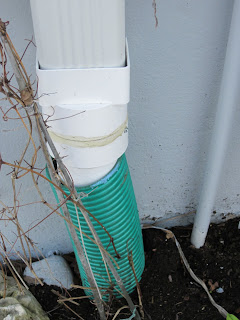Although I can not say with total statistical accuracy, I am going to go out on a limb and say that somewhere between 60% and 75% of homes in the city of Hamilton, where I live, have downspouts that are directly routed into above ground pipes that go directly into the city storm sewers.
I don't know what genius decided years ago that we should route downspouts from the eavestrough directly into the storm sewers. Who ever it was came up with one of the worst home improvement ideas EVER! Of course, that was a different generation and houses were smaller and there were fewer of them. With the advent of more homes and larger homes, the cities and municipalities realize that it is just bad news to have all this water from houses directly piped into the the storm sewers. When there is a huge rain or a massive amount of snow that melts fast, the storm sewers can not handle all the water and it backs up and floods homes.
Can you imagine what could happen if this clay pipe fails during a heavy rain? It very likely would flood water right into this window well. If you have a downspout that looks like this one you might want to give serious thought to rerouting your downspouts or replacing your eavestrough! Often times people ask me if I can just move the downspout to the other end of the house. My comment is, "Yes, I can, but your eavestrough were designed to slope to this downspout." So you can't just relocate a downspout, without readjusting the eavestrough. More often than not, taking old eavestrough off a house and re-sloping it, is more costly than just replacing the old eavestrough with new eavestrough.
While I was out giving estimates today, I took a couple pictures of neighboring houses. These houses were only about 15 feet away from each other!
When designing a new eavestrough system for this home every effort must be made to move this downspout to a new location and route the roof water onto your lawn or into a garden. You can also do as I did on my home and route the downpipes under the ground via a a plastic 4" pipe and out to the street! You do need to have enough slope to do this! Here's how I did it!
Notice first that I removed the downpipe from the pipe going down into the weeping tile. I then capped the pipe permanently!
I then replace my eavestrough and moved the downpipe around the corner and placed it into an underground pipe that DOES NOT go into the storm sewer. I should have used black plastic pipe but I used green. The downpipe I used is the extra large 4x3 pipe.
I then took this green drainage pipe some 30 feet under the ground and out to the road and this is where my roof water comes out.
My neighbor and I have our garages really close together, so we actually created a drain in between our garages and placed a drain there for the roof water to go under the ground and out to the road. All the roof water on my house is deposited some 30 feet away from my house. See the picture below:
However you decide to do it, get the downpipes out of the storm sewer to prevent basement flooding! Just make sure you do it properly! I am doing a job soon for a woman in Hamilton whose only option in removing the downpipes from the weeping tile was to spill some of the water on her driveway. She just could not bear the thought of the roof water going onto the driveway and causing icing issues in the winter time, which it will. So in discussing the matter with her, we decided that we could remove around 80% of her roof water into downpipes that will spill onto her lawn and garden areas. The other 20% will be going into her storm sewer. However, I did convice her to get a premium quality gutter protection product to prevent debris from entering into her strom sewer pipes.
For quality eavestrough work, contact The Eavestrough Company at www.theavestroughcompany.com or phone us at 905-966-2564.








No comments:
Post a Comment
I welcome your comments or opinions on my blog writings. Please comment. :)